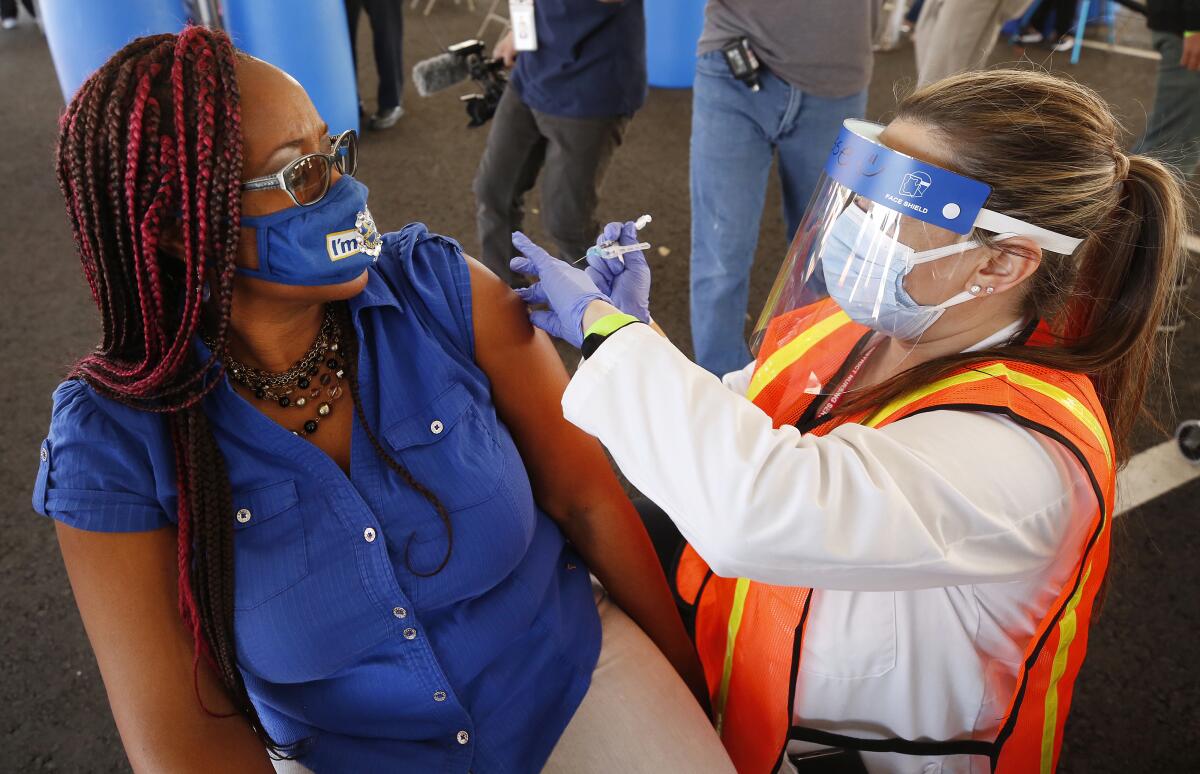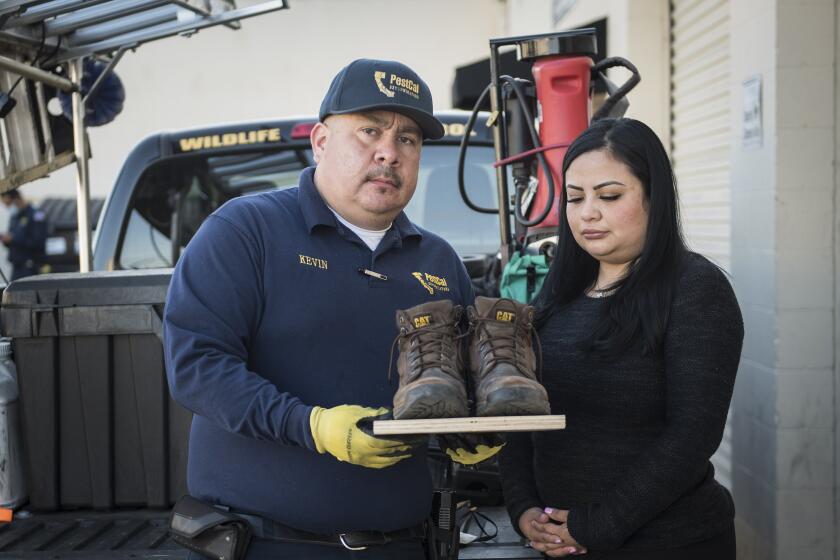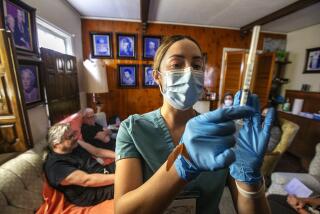L.A. County falls far behind Bay Area in vaccinating Black, Latino residents

- Share via
Concerns are mounting over the continued low vaccination rates among Black and Latino residents in Los Angeles County as California heads into winter facing another coronavirus surge and bracing for the rise of the Omicron variant.
Los Angeles County’s vaccination numbers in communities of color now lag significantly behind several San Francisco Bay Area counties — including San Francisco, Alameda and Santa Clara — data show, despite what L.A. area officials describe as aggressive outreach in Black and Latino neighborhoods.
Authorities have been struggling with the disparity since vaccines became available. But the situation is becoming more urgent, with coronavirus cases rising significantly in recent weeks and the specter of a swiftly spreading Omicron variant looming. Vaccinations are a central strategy to fight both the Delta and Omicron variants, with a push for people to get their first doses as well as boosters.
California health officials have warned that coronavirus case rates statewide have risen by almost 50% in the last 2½ weeks, and COVID-19 hospitalizations are up by nearly 15%. Vaccination rates statewide, although better than in many places, are still far from ideal: 65% of Californians of all ages are fully vaccinated, and only about 30% of fully vaccinated adults have received a booster shot.
Rates of coronavirus infections, hospitalizations and deaths have disproportionately hit Black and Latino communities the hardest during previous COVID-19 surges. Those residents, public health officials point out, are more likely to have jobs that require them to physically go to work and live in crowded housing, increasing the risks of viral exposure and infection.
The pandemic has affected Latinos from all walks of life, attacking their families, their health as well as their financial well-being. The impacts will be felt for generations, and have implications for all Californians.
Among Los Angeles County residents ages 5 and older, only 56% of Black residents have received at least one dose of vaccine, as have 61% of Latino residents. By contrast, 74% of white, 77% of Native American and 83% of Asian American residents have received at least one dose.
In Orange County, just 48% of Latino residents have had at least one dose, compared with 69% of Black, 70% of white, 73% of Native American and more than 90% of Asian American residents.
Dr. Muntu Davis, Los Angeles County health officer, said there are many questions asked by people who still haven’t received their shots, including: Are the vaccines effective? Should people wait for a new vaccine to come out before getting vaccinated? Do people need to get vaccinated if they’ve already been infected with the coronavirus?
Davis said the county’s mobile vaccination sites, working alongside community groups and faith-based organizations, have increased vaccination rates. He said officials are going to continue having conversations to build trust and talk to unvaccinated people to understand what the department can do differently. He also said the department is going to look into improving its community ambassador and youth ambassador programs so more people can be trained to talk to others about COVID vaccinations.
“Even though the gaps aren’t closing, we are still seeing increases across all the populations in terms of increasing vaccinations across racial and ethnic groups,” Davis said. “It’s something that’s good, but there are lots of folks that are doing a lot of hard work on the ground to get people vaccinated and protected against what we’re seeing.”
It’s far from clear why some parts of the Bay Area have achieved higher vaccination numbers in communities of color.
Officials in both regions have partnered with local, trusted community based organizations to promote vaccinations. Both regions report having to address vaccine misinformation such as the false claim that the shots affect fertility.
But the numbers are striking.
In Santa Clara, Northern California’s most populous county, Black, Latino and white residents have much closer vaccination rates: 69% of Black and 73% of Latino residents of all ages have received at least one shot, compared with 74% of white, 88% of Native American and more than 90% of Asian American residents.
In San Francisco, Black and white residents have essentially the same rate of receiving at least one dose of vaccine: 76% of Black residents have received a shot, and 75% of white residents have done so. Rates are even better in other groups: 87% of Asian Americans have received at least one dose, and so have more than 90% of Latinos and Native Americans.
And in Alameda County, which is home to Oakland, disparities remain but are much less pronounced than in Los Angeles County. Among residents of all ages, 67% of Black and 68% of Latino residents have received at least one dose, compared with 76% of white, 88% of Asian American and more than 90% of Native American residents.
Dr. Marty Fenstersheib, Santa Clara County’s vaccine and testing officer, said the county conducted analysis on the census tract level to determine where they should target — identifying neighborhoods where case rates have been high and vaccination rates are low, then bringing vaccination advocates to that area and following up the effort with a vaccination clinic.
Officials also formed a community stakeholder group that met weekly, where the county could quickly respond to specific concerns expressed among residents. The county worked to send groups of trained monolingual Spanish speakers into the community to go door to door, answering questions on vaccinations and offering coronavirus tests.
School districts also got in the action, setting up virtual town halls where parents could ask questions, answered by public health officials, with breakout rooms in other languages, including Spanish and Vietnamese. Officials established large vaccination sites in areas of highest need and have a large mobile vaccination team that can be set up at places such as shopping centers, churches and schools.
A good deal of work and patience are needed. Even people who come to vaccine clinics may end up leaving without getting a shot. Fenstersheib recounted one situation where a vaccine team member spent half an hour with a single person to answer questions; he eventually got the shot.
The Los Angeles County Department of Public Health has several outreach initiatives, including working with 59 community-based organizations, using WhatsApp to connect with Latino and Black populations and working with local barbershops. Davis said community organizations have given feedback that more families of color who waited until everyone in their family was eligible want to get vaccinated together with a provider they trust.
“There’s not so much hesitancy per se, but still questions and wanting to do things together as a family and doing it not just for themselves, but for the whole family in general,” Davis said.
He said as more information becomes available about the Omicron variant, it will be important to see if people will wait for another vaccine before getting their first dose.
Federal health officials have implored people to not wait to get a theoretical future vaccination that targets the Omicron, saying the current vaccinations and boosters still provide substantial protection against severe illness and death, even if the new variant results in decreased effectiveness against symptomatic illness. Authorities also say it’s important to get vaccinated even for people who have already been infected because the strength of immunity resulting from an infection can weaken over time.
Asked about Bay Area counties’ efforts closing racial disparities with vaccination rates, Davis said Los Angeles County has more people to consider, governing a population of more than 10 million people, for instance, compared with Santa Clara County’s nearly 2 million residents and San Francisco’s 870,000 people. He said there’s nothing he can recall those counties doing that Los Angeles County has not done already and that “hearing from our own community, is really the best thing that we can do.”
“If you want to say that we haven’t been successful, I think that would be wrong. Have we gotten to the ultimate goal of closing the gaps across all of our racial ethnic groups? No, we haven’t. And that’s something we struggle with on a lot of things across a lot of different health measures. But we continue to be here, we continue to work and we continue to try to improve,” Davis said.
It can be sometimes perplexing why different counties have different results. Are some counties more persistent than others? Could it be that community leaders in some areas are more pro-vaccine than in others?
Sometimes, the explanations are more obvious. Farmworker advocates have struggled with vaccine disinformation in the San Joaquin Valley, but in the Coachella Valley and Imperial County, vaccination rates soared after a beloved Catholic priest — before vaccines were widely available — died of COVID-19, and residents got vaccinated in his honor.
Dr. Regina Chinsio-Kwong, a deputy health officer for Orange County, expressed optimism that outreach efforts were still working, including a decent demand in vaccine clinics established in heavily Latino areas.
One factor to remarkably low rates of reported vaccination among Orange County’s Latino population could be that Latino people there are less likely to disclose their race and ethnicity when getting a vaccine. There are relatively high rates of no responses to that question among residents in heavily Latino areas, Chinsio-Kwong said.
But there were no easy answers to explain why Orange and San Diego counties have such different rates of vaccination by race and ethnicity. Although Orange County has low recorded vaccination rates among Latino people and high rates among Black and Native American residents; in San Diego County, Latino people have high vaccination rates, but Black and Native American residents lag far behind.
More to Read
Sign up for Essential California
The most important California stories and recommendations in your inbox every morning.
You may occasionally receive promotional content from the Los Angeles Times.














